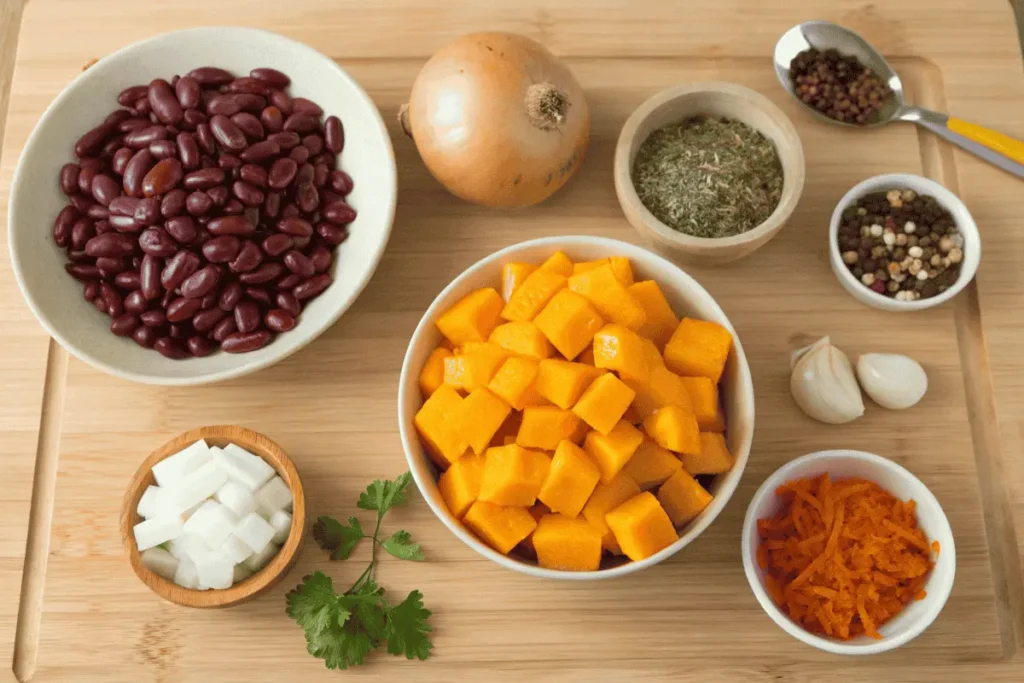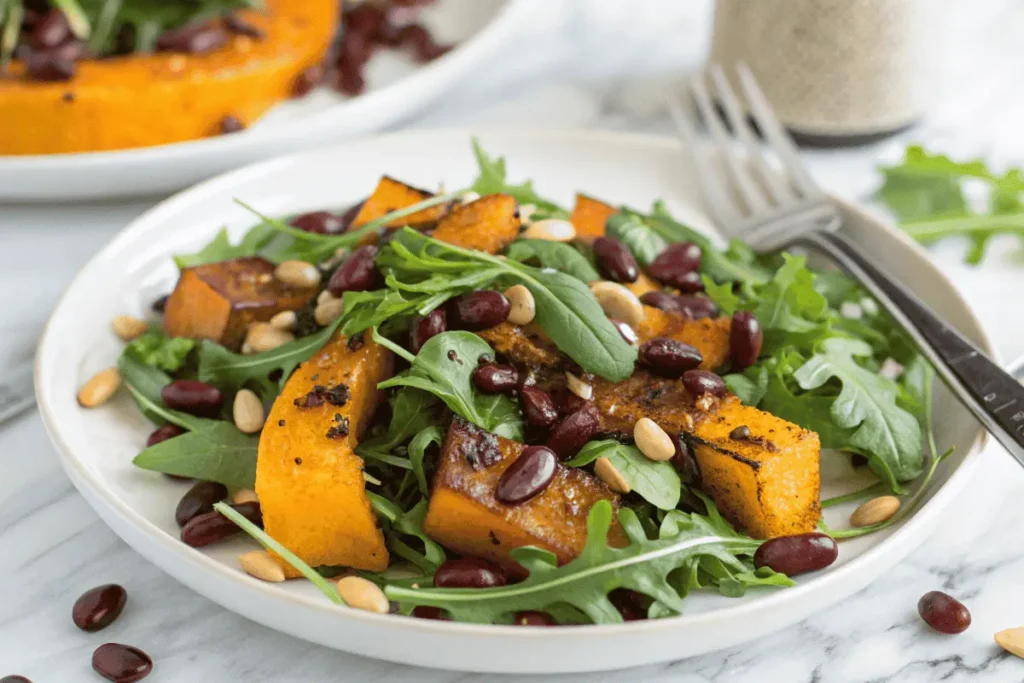There’s something magical about the humble pairing of squash and kidney beans. Together, they create hearty, nutritious dishes bursting with flavor and versatility. Whether you’re crafting a comforting stew, a vibrant salad, or a creative twist on chili, this combination is as delightful as it is healthy. This article dives into the recipe squash and kidney beans, exploring its health benefits, essential ingredients, and preparation techniques. You’ll also discover creative variations and tips to make the most of this power-packed duo. Ready to get cooking? Let’s jump in!
Introduction to Squash and Kidney Beans Recipes
Why Combine Squash and Kidney Beans?
At first glance, squash and kidney beans might seem like an unlikely duo, but their complementary qualities make them a match made in culinary heaven. Squash brings a natural sweetness and creamy texture, while kidney beans add heartiness and a dose of protein. Together, they create a balanced meal that satisfies both taste buds and nutritional needs.
Squash is incredibly versatile, available in varieties like butternut, acorn, and spaghetti squash, each offering a unique flavor. Kidney beans, with their earthy and slightly nutty taste, are a staple in cuisines worldwide. When combined, they form the backbone of countless comforting and nourishing dishes.
Health Benefits of Squash and Kidney Beans
Both ingredients are nutritional powerhouses. Squash is rich in vitamins A and C, which boost immunity and improve skin health, while kidney beans are packed with plant-based protein, iron, and fiber, supporting digestion and sustained energy. Together, they create meals that are low in fat but full of flavor and nutrients.
Popular Cuisines Featuring These Ingredients
From the spicy stews of the Caribbean to the vibrant curries of India, squash and kidney beans recipes have found their way into diverse culinary traditions. In the Americas, they’re a favorite in fall-inspired dishes, while in Europe, they’re often featured in comforting casseroles. Their global appeal ensures endless inspiration for home cooks.
Essential Ingredients and Preparations

Choosing the Right Type of Squash
The foundation of a great recipe squash and kidney beans is selecting the perfect squash. Each variety offers unique textures and flavors. For a creamy, slightly nutty taste, go for butternut squash. Acorn squash adds a subtle sweetness and works well in roasts, while spaghetti squash introduces a light, stringy texture perfect for soups or casseroles. Whichever type you choose, make sure it’s ripe—a firm exterior and vibrant color are key indicators.
Kidney Beans: Fresh, Canned, or Soaked
Kidney beans are the protein powerhouse in this dish, and choosing the right type is crucial. Canned beans save time, but rinse them well to remove excess sodium. If you prefer dried beans, soak them overnight and cook them thoroughly until tender. This ensures the beans blend seamlessly into the recipe, enhancing both texture and flavor.
For step-by-step inspiration on how to prepare dried kidney beans, visit Squash and Kidney Beans Recipe.
Additional Ingredients to Enhance Flavor
While squash and kidney beans are the stars, supporting ingredients make the dish shine. Aromatics like onions, garlic, and ginger lay the flavor foundation. Spices such as cumin, smoked paprika, and turmeric add warmth and depth. To balance the richness, consider a splash of citrus juice or a handful of fresh herbs like cilantro or parsley. These additions elevate your recipe squash and kidney beans to restaurant-quality goodness.
Step-by-Step Guide to Making Squash and Kidney Beans Recipe
Preparing the Squash: Peeling, Chopping, and Roasting
Start by peeling the squash. A sharp peeler works wonders on butternut squash, while acorn squash can be baked with the skin on for added texture. Chop the squash into even cubes to ensure uniform cooking. To amplify the flavor, roast the cubes in the oven with a drizzle of olive oil, salt, and pepper at 400°F (200°C) for about 25 minutes, or until tender and caramelized.
Cooking Kidney Beans: Techniques for Perfect Texture
For dried beans, soak them overnight in water with a pinch of baking soda. This reduces cooking time and improves texture. Once soaked, boil them in fresh water until tender, about 45 minutes to an hour. Canned beans, on the other hand, are ready to use after a quick rinse. Warm them gently with a bit of olive oil and a pinch of salt before combining with the squash.
Combining Ingredients for Maximum Flavor
Heat a large skillet or pot and sauté onions, garlic, and ginger until fragrant. Add the roasted squash, followed by the cooked kidney beans. Sprinkle in your chosen spices—smoked paprika, cumin, and turmeric are great options. Stir everything together, allowing the flavors to meld. Finish with a squeeze of lemon juice or a handful of fresh herbs for a bright, fresh finish.
Creative Variations for Squash and Kidney Beans

Squash and Kidney Bean Chili
If you’re craving something hearty, a squash and kidney bean chili is the way to go. Start with a base of sautéed onions, garlic, and bell peppers, then add diced tomatoes and your favorite chili spices, like cumin, smoked paprika, and a touch of cayenne. Toss in roasted squash cubes and cooked kidney beans, letting the flavors simmer together. This variation is perfect for a cozy dinner or meal prep. Serve it with cornbread or tortilla chips for added comfort.
Roasted Squash and Bean Salad
Looking for a lighter option? Try a roasted squash and bean salad. Combine roasted butternut squash cubes with kidney beans, arugula, and a tangy vinaigrette made with olive oil, lemon juice, and Dijon mustard. Sprinkle toasted pumpkin seeds and crumbled feta cheese on top for texture and flavor. This recipe squash and kidney beans variation is great for lunch or as a side dish at gatherings.
Squash and Bean Curry with Coconut Milk
For a creamy, aromatic twist, turn this duo into a curry. Sauté onions, garlic, and ginger, then add curry paste, coconut milk, and vegetable broth. Toss in roasted squash and kidney beans, letting the curry simmer until it thickens. Serve over steamed rice or with warm naan bread. It’s a comforting dish with global appeal.
For more inspiration, explore related dishes like Squash and Kidney Beans Recipe.
How to Serve Squash and Kidney Beans Recipes
Serving Suggestions for Every Occasion
The beauty of recipe squash and kidney beans is its versatility. For a casual family dinner, serve the dish with fluffy rice or warm crusty bread to soak up the flavorful sauce. If you’re hosting a dinner party, plate it elegantly with a garnish of fresh herbs and a drizzle of olive oil. For outdoor gatherings, consider pairing a roasted squash and kidney bean salad with grilled vegetables or a light soup.
Pairing Ideas: Sides and Drinks
Elevate your dish with complementary sides and drinks. For spicy variations, a creamy yogurt or tzatziki dip balances the heat. Bread-based sides like naan or cornbread are perfect for scooping up hearty chilis and curries. On the beverage front, a crisp white wine or a citrusy mocktail pairs beautifully with the natural sweetness of squash. If you’re keeping it casual, iced tea or a sparkling water with a twist of lime makes a refreshing choice.
Storage and Leftover Tips
How to Store Squash and Kidney Bean Dishes
Proper storage ensures your recipe squash and kidney beans stays fresh and flavorful. Once cooled, transfer the dish to an airtight container. It can be refrigerated for up to 4 days. For longer storage, freeze individual portions in freezer-safe containers or bags; they’ll keep well for up to 3 months. When freezing, label each container with the date to track freshness.
Reheat leftovers on the stovetop over medium heat, adding a splash of water or broth to restore moisture. For microwave reheating, use a covered dish to retain the dish’s original texture and flavor.
Creative Ways to Repurpose Leftovers
Leftovers don’t have to feel repetitive. Transform your recipe squash and kidney beans into new dishes with a few simple tweaks. For example:
- Wrap the mixture in a tortilla for a hearty veggie burrito.
- Add it to a pot of vegetable broth and diced tomatoes to create a flavorful soup.
- Mash it slightly and use it as a topping for baked potatoes.
These easy transformations make the most of your dish while keeping meals exciting.
FAQs About Squash and Kidney Beans Recipes
Can I Use Different Types of Beans?
Absolutely! While kidney beans are traditional in this recipe squash and kidney beans, you can substitute with black beans, cannellini beans, or even chickpeas for a unique twist. Each type of bean brings its own flavor and texture, adding variety to your dish.
What Are the Best Spices for These Recipes?
Spices are key to elevating the flavors in your dish. Common choices include cumin, smoked paprika, turmeric, and coriander. For heat, add chili flakes or cayenne pepper. To brighten the flavor, finish with fresh herbs like cilantro or parsley.
Can I Make These Recipes Vegan or Gluten-Free?
Yes! Most squash and kidney bean recipes are naturally vegan and gluten-free. Use plant-based oils and broths to ensure the dish remains vegan-friendly. Double-check ingredient labels, especially for store-bought sauces or spice blends, to confirm they’re gluten-free.
How Do I Prevent Beans from Becoming Mushy?
To maintain the perfect bean texture, avoid overcooking them. If using canned beans, add them toward the end of cooking to prevent them from breaking down. For dried beans, cook them until just tender before incorporating them into your recipe squash and kidney beans.
Tips for Perfecting Your Recipe Squash and Kidney Beans
Common Mistakes to Avoid
Even with the best intentions, it’s easy to make small mistakes when preparing your recipe squash and kidney beans. One common pitfall is undercooking the squash. To ensure it cooks evenly, chop it into uniform pieces and test for tenderness with a fork. Another frequent issue is over-seasoning. While spices enhance the dish, adding too much can overpower the natural sweetness of the squash and the earthy flavor of the beans. Start small and adjust as needed.
Finally, avoid using canned beans straight from the can. Rinsing removes excess salt and improves their texture, ensuring a fresh-tasting dish.
Pro Tips for Success
To make your recipe squash and kidney beans stand out, use fresh, high-quality ingredients. Opt for ripe, vibrant squash and beans with a firm texture. Enhance the dish’s flavor by roasting the squash with a drizzle of olive oil and your favorite spices before adding it to the recipe.
For a richer flavor, toast your spices in the pan before adding other ingredients. This simple step releases their aromatic oils and deepens their taste. Lastly, finish the dish with a sprinkle of fresh herbs or a splash of citrus juice to brighten the flavors.
Why Recipe Squash and Kidney Beans Is a Must-Try
A Nutritious and Versatile Dish
The recipe squash and kidney beans isn’t just delicious—it’s also packed with nutrients. The natural sweetness of squash pairs perfectly with the hearty protein and fiber of kidney beans, creating a well-balanced dish. Whether you’re following a plant-based diet or looking to add more vegetables to your meals, this recipe delivers both flavor and nutrition.
A Dish for Every Occasion
This recipe’s versatility makes it ideal for any setting, from casual family dinners to holiday gatherings. It can be served as a main course or a side dish, and the flavor combinations can be tailored to fit various cuisines. For example, add curry spices for an Indian-inspired dish, or try chili powder for a Tex-Mex twist.
With simple ingredients and endless possibilities, this recipe squash and kidney beans is a must-try for home cooks of all skill levels. Once you’ve mastered the basics, you can customize it to suit your preferences, making it a staple in your kitchen.

